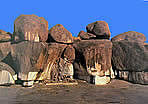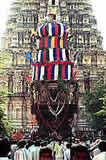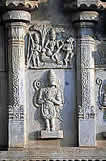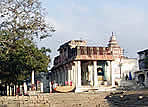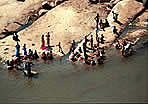| Mythical Landscape |
| For pilgrims to Vijayanagara the most important aspect of the site is the association with various myths and legends. Many of the granite hills, caves and boulders of the Tungabhadra valley are linked with these stories, which are still very much alive and attract a steady procession of devotees. The first of these legends relates the story of Virupaksha’s marriage to Pampa, a beautiful local maiden (after whom the village of Hampi takes its name). Hemakuta hill above Hampi marks the spot where Pampa worshiped Shiva with great devotion, thereby attracting the attention of the god, who agreed to marry her. The betrothal and marriage of Pampa to Shiva under the name of Virupaksha are still celebrated. The engagement, which takes place in the November, includes a ceremony in which the gods are serenaded by priests as their barge is rowed around the temple tank. The marriage in April involves the pulling of two chariots along the bazaar street of Hampi. Throughout the year, devotees pay homage to the god and goddess in their shrines within the Virupaksha complex at Hampi. They then visit the shrines on Hemakuta hill, and perhaps even take a boat trip down the Tungabhadra to visit a small tank known as Pampasarovar, where Pampa is supposed to have bathed. The Ramayana epic is equally important in the mythological landscape. The Vijayanagara site is believed to be Kishkindha, the monkey kingdom where the episodes of one of the chapters of the Ramayana took place. According to the story, Rama and Lakshmana arrived in Kishkindha in search of Sita, who had been carried off by his flying chariot by Ravana, the king of the demons. As the chariot had flown over Kishkinda, Sita had dropped her ornaments and a garment in the hope that they would show Rama in which direction she was being carried away. Sugriva, a claimant to the Kishkindha throne, who had been deposed by his brother Vali, recovered and hid them in a cave. When they arrived on the bank of Pampa lake, Rama and Lakshmana visited the cave of the female ascetic, Shabari, a disciple of the sage Matanga. Near Rishyamuka hill they met Hanuman, the monkey general, who told them about Sugriva. Rama then met Sugriva and agreed to restore his position. After Vali was killed by an arrow shot by Rama, and Sugriva was crowned, the rainy season began and Rama and Lakshmana waited on Malyavanta hill. At the end of the wet season Rama asked the monkeys to help him find Sita. After several adventures Hanuman located Sita on Ravana’s island kingdom of Lanka. Hanuman returned with the good news and Rama then planned the campaign to Lanka to win Sita back. Among other features at Vijayanagara with Ramayana associations is Pampasaras where Rama sought the goddess’s protection and where Shabari sheltered. Matanga hill, one of the highest points of the site is named after a sage who protected Sugriva against Vali and who guided Shabari. Immediately beneath the hill, on the south bank of the Tungabhadra, is a boulder carved with the figures of Rama, Lakshmana, Sita and Hanuman. This marks the spot where Lakshmana crowned Sugriva. The boulder is incorporated into the Kodandarama Temple. The bathing spot nearby, Chakra tirtha, is the holiest at Vijayanagara. Here, Shiva gave Vishnu one of his most powerful weapons, the Chakra. The tirtha is situated at a point where the Tungabhadra turns northwards, giving an unimpeded view of Anjanadri hill on the opposite bank, about 1 kilometre way. Anjanadri hill is named after the mother of Hanuman, who is supposed to have been born here. Another Ramayana feature of interest is Sugriva’s cave, a natural cleft in the boulders a short distance downstream from the Kodandarama Temple. Here, Sugriva is believed to have hidden the jewels that Sita dropped from Ravana’s aerial chariot. Malyavanta hill in the eastern part of the site is where Rama and Lakshmana waited while Hanuman sought Sita. For more on the religious associations of the site link to Cults and Practices. |
|
|||||||||
| Top |
